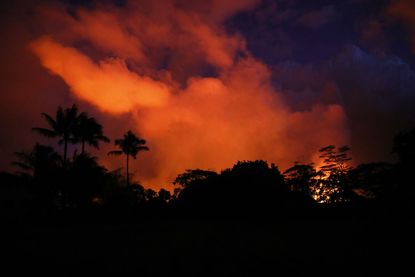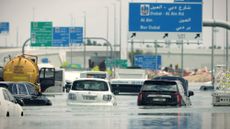This is why volcanic clouds move so fast

The dangers of volcanoes don't end at hot magma and falling rocks — you also have to worry about the plumes of ash, smoke, and toxic gases that are just as deadly, but reach a lot farther. Thanks to new research, scientists might be able to better understand how these volcanic clouds work, and how we can minimize their damage.
Clouds of volcanic debris, known as "pyroclastic density currents," have long been a mystery because they move much faster than they should be able to, National Geographic explained. They stick to ground level and seem to have an unnatural momentum that allows them to race downhill, on level surfaces, and even uphill. But a new study published Monday in the journal Nature Geoscience revealed that volcanic gases are able to spread at abnormal speeds thanks to a cushion of air that reduces the amount of friction they encounter in their path.
Using volcanic debris left behind by a volcanic eruption 2,000 years ago in New Zealand, researchers studied the way the pyroclastic flow moved, and were able to model the movement on computers. This data led them to the realization that air trapped between the toxic particles in the pyroclastic current drifted to the bottom of the clouds, buffering the current from any rough surfaces it might pass over. It's similar to the way an air hockey table works: The puck gains speed because of the layer of air that lifts it from the table's surface.
Subscribe to The Week
Escape your echo chamber. Get the facts behind the news, plus analysis from multiple perspectives.

Sign up for The Week's Free Newsletters
From our morning news briefing to a weekly Good News Newsletter, get the best of The Week delivered directly to your inbox.
From our morning news briefing to a weekly Good News Newsletter, get the best of The Week delivered directly to your inbox.
Although the data needs to be refined, it can be a tool in predicting where future eruptions' volcanic gases and ash might end up. That information, in turn, can be used to save the lives of the 800 million people who live within 60 miles of active volcanoes around the world.
Read more about this study at National Geographic.
Create an account with the same email registered to your subscription to unlock access.
Sign up for Today's Best Articles in your inbox
A free daily email with the biggest news stories of the day – and the best features from TheWeek.com
Shivani is the editorial assistant at TheWeek.com and has previously written for StreetEasy and Mic.com. A graduate of the physics and journalism departments at NYU, Shivani currently lives in Brooklyn and spends free time cooking, watching TV, and taking too many selfies.
-
 'A speaker courageous enough to stand up to the extremists in his own party'
'A speaker courageous enough to stand up to the extremists in his own party'Instant Opinion Opinion, comment and editorials of the day
By Harold Maass, The Week US Published
-
 How could the Supreme Court's Fischer v. US case impact the other Jan 6. trials including Trump's?
How could the Supreme Court's Fischer v. US case impact the other Jan 6. trials including Trump's?Today's Big Question A former Pennsylvania cop might hold the key to a major upheaval in how the courts treat the Capitol riot — and its alleged instigator
By Rafi Schwartz, The Week US Published
-
 Today's political cartoons - April 18, 2024
Today's political cartoons - April 18, 2024Cartoons Thursday's cartoons - impeachment Peanuts, record-breaking temperatures, and more
By The Week US Published
-
 Arid Gulf states hit with year's worth of rain
Arid Gulf states hit with year's worth of rainSpeed Read The historic flooding in Dubai is tied to climate change
By Peter Weber, The Week US Published
-
 How the EU undermines its climate goals with animal farming subsidies
How the EU undermines its climate goals with animal farming subsidiesUnder the radar Bloc's agricultural policy incentivises carbon-intensive animal farming over growing crops, despite aims to be carbon-neutral
By Harriet Marsden, The Week UK Published
-
 EPA limits carcinogenic emissions at 218 US plants
EPA limits carcinogenic emissions at 218 US plantsSpeed Read The new rule aims to reduce cancer-causing air pollution in areas like Louisiana's 'Cancer Alley'
By Peter Weber, The Week US Published
-
 How Taiwan minimized earthquake damage
How Taiwan minimized earthquake damageThe Explainer The country was rocked but not rolled
By Devika Rao, The Week US Published
-
 Strong Taiwan earthquake kills 9, injures hundreds
Strong Taiwan earthquake kills 9, injures hundredsSpeed Read At magnitude 7.4, this was Taiwan's biggest earthquake in 25 years
By Peter Weber, The Week US Published
-
 EPA sets auto pollution rule that boosts EVs
EPA sets auto pollution rule that boosts EVsSpeed Read The Biden administration's new rules will push US automakers toward electric vehicles and hybrids
By Peter Weber, The Week US Published
-
 Chimpanzees are dying of human diseases
Chimpanzees are dying of human diseasesUnder the radar Great apes are vulnerable to human pathogens thanks to genetic similarity, increased contact and no immunity
By Harriet Marsden, The Week UK Published
-
 Can the world really wean itself off coal?
Can the world really wean itself off coal?Today's Big Question 'Record' global consumption is set to fall soon but growing demand in China and India could increase tensions
By Harriet Marsden, The Week UK Published